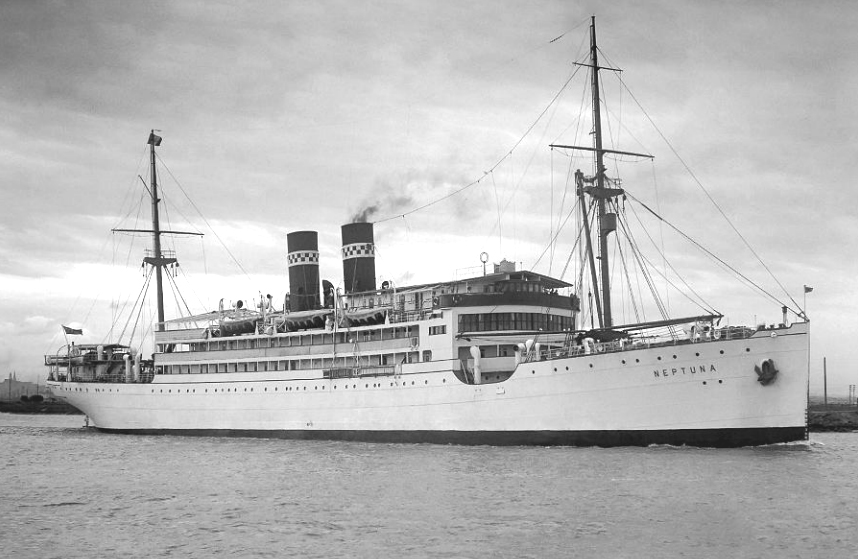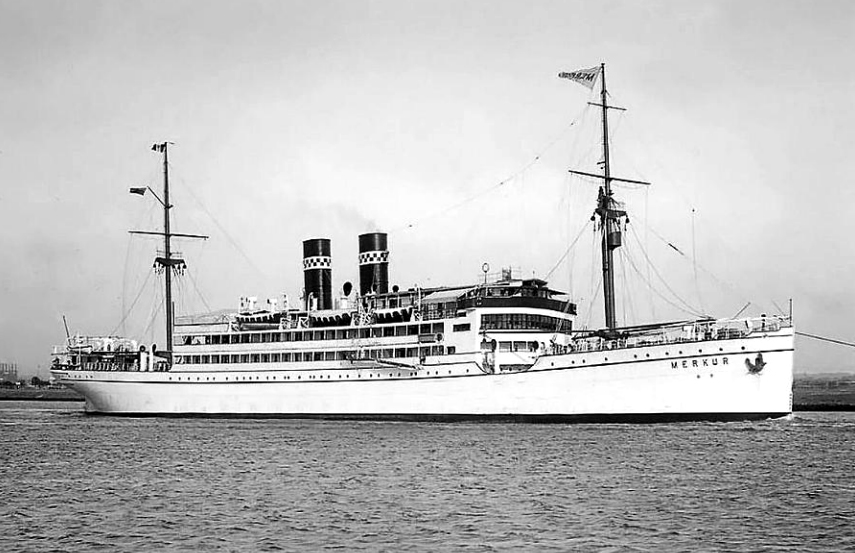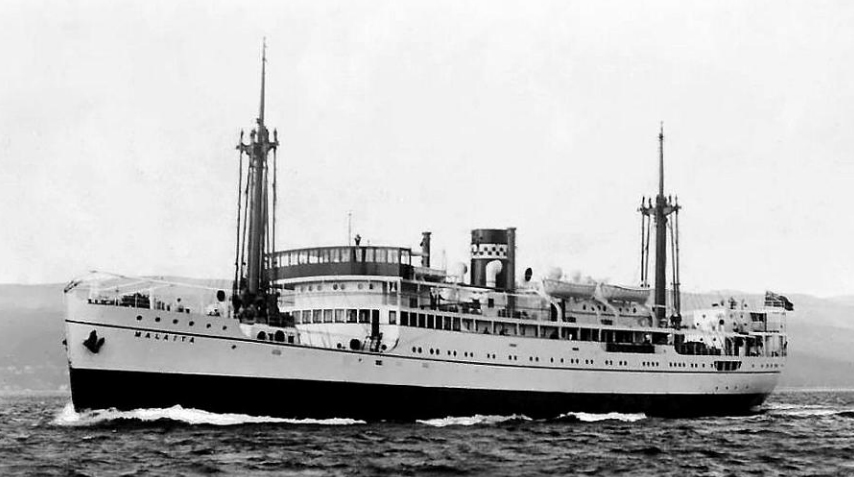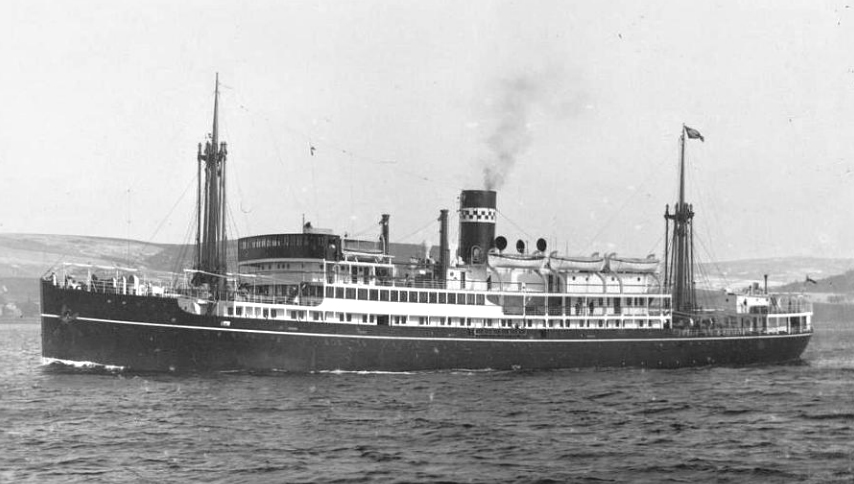Neptuna (Burns Philp)
 Departing from Sydney in August 1941 for Hong Kong via Papua New Guinea, Neptuna disembarked troops and discharged cargo at Port Moresby and Rabaul, the latter including two mobile 3-inch anti-aircraft guns. On the return voyage from Hong Kong, she was ordered to shelter in Madang from the predations of a German commerce raider
suspect in the area. Her voyage continued after a few days.
Departing from Sydney in August 1941 for Hong Kong via Papua New Guinea, Neptuna disembarked troops and discharged cargo at Port Moresby and Rabaul, the latter including two mobile 3-inch anti-aircraft guns. On the return voyage from Hong Kong, she was ordered to shelter in Madang from the predations of a German commerce raider
suspect in the area. Her voyage continued after a few days.
The ship was at Manila when Japan entered the Second World War on 7 December 1941, and homeward-bound was diverted to Rabaul, Madang, Lae and Salamaua to evacuate civilians ahead of the Japanese threat. Some were disembarked at Townsville, reducing the unauthorized overload, and the ship reached Sydney on 31 December. Neptuna then commenced loading Defence stores and equipment, “topping up” at Sydney’s explosive anchorage with two hundred depth charges (stowed in the aft holds) and a large quantity of anti-aircraft shells, thus virtually becoming an ammunition ship.
Following a number of cargo loading delays due to industrial disputes, the ship eventually sailed at the end of January 1942, reaching her destination Darwin on 12 February. There, due to port congestion, she was ordered to a particular anchorage, with indications of her being there for some time. Major engine repairs on one of its two main engines were thus undertaken. Six days later a merchant ship convoy, returned with significant Australian and United States naval escort from the Timor area, having suffered some Japanese air attacks.
Moving to the wharf early on 19 February and commencing ammunition discharge both to wharf and an alongside HMAS “Swan”, this operation (being assisted by crew members) incurred industrial wrath and confrontation. At this time, what was first thought to be leaflets from aircraft turned out to be a major Japanese bombing raid. Neptuna initially suffered hull damage from a nearby explosion, then three direct hits. Listing, her crew were ordered to abandon ship, some jumping into the harbour. Then, fire entering the explosives holds, the ship blew apart. Killed were the Master and nine officers (out of twenty-one) and forty-five of the one hundred and twenty-five Chinese crew. Seven awards for bravery, some posthumous, were made in connection with this event, reflecting as it did, a lack of preparedness for and total commitment by some towards unreserved prosecution of the war.
Read moreDate posted: 2014-02-28 | Comments(0)
Montoro (Burns Philp)
 Undertook extensive trooping duties Australia-southern to northern ports-Papua New Guinea
Undertook extensive trooping duties Australia-southern to northern ports-Papua New Guinea
Date posted: 2014-02-28 | Comments(0)
Merkur (Burns Philp)
 On the outbreak of war with Japan in 1941, the Australian Government requisitioned Merkur as a Fleet Victualling Store Issue Supply Ship, providing support to Allied naval units in the Western Pacific, from Noumea to the Philippine Islands.
On the outbreak of war with Japan in 1941, the Australian Government requisitioned Merkur as a Fleet Victualling Store Issue Supply Ship, providing support to Allied naval units in the Western Pacific, from Noumea to the Philippine Islands.
She carried out this role to war’s end, and reasonably well armed by 1945, was fortunately never singled out for individual enemy attack. However while in Seeadler Harbour during the assembly of the fleet for the Philippines re-capture, she sustained minor damage when an American-marked aircraft (pilot unknown), flying fast at masthead height, hit a neighbouring ship loaded with ammunition, blowing it out of the water with a massive explosion.
From 1946 Merkur remained under charter to the Australian Government, being employed in the transport of service personnel and stores to the Kure, Japan base of the British Commonwealth Occupation Force’s Australian Component. She continued in this role until 1948, being handed back to owners after refit the following year.
Read moreDate posted: 2014-02-28 | Comments(0)
Malaita (Burns Philp)
 Part of the ‘fleet’ evacuating civilians from Pacific islands during 1941in recognition of the Japanese threat, Malaita spent the first months of 1942 carrying troops and equipment from eastern Australia to Papua New Guinea.
Part of the ‘fleet’ evacuating civilians from Pacific islands during 1941in recognition of the Japanese threat, Malaita spent the first months of 1942 carrying troops and equipment from eastern Australia to Papua New Guinea.
One voyage concluded with her arrival and anchoring in Port Moresby on 23 August 1942. Having disembarked her troops promptly, Malaita was not able to berth at the wharf until late on 27 August. She completed discharge on the morning of 29 August and sailed for Australia under escort of the destroyer HMAS “Arunta”. Japanese submarine RO.33 had taken up position off Basilisk Reef and as Malaita passed, torpedoed her. Though heeling over seriously and following the crew abandoning and then re-boarding the ship, she was towed by three vessels, Arunta, Matafele and Potrero, to shallow water. HMAS “Arunta” sank the submarine the same day.
Two days later the ship was moved to a safe anchorage and assisted by others to replenish lost water and stores. Power and wireless capabilities were restored. The extensive below-waterline damage indicated that repairs were beyond local capacity and it was resolved these must be effected in Australia. In the hope of favourable weather, Malaita again left Port Moresby on 15 September with Cairns its objective. Five days and 790 miles (nearly 1300 kilometres) later she reached there.
After some hull-strengthening in Cairns, she commenced the hazardous voyage south still coping with her severe damage and sheltering from heavy weather along the New South Wales coast. High quality of seamanship led to her reaching Sydney on 13 November where damage was regarded as so great that her wartime duties were now at an end. Repairs, commenced in October 1945, were not completed until April 1947.
Read moreDate posted: 2014-02-28 | Comments(0)
Macdhui (Burns Philp)
 Having participated in the evacuation of civilians from Pacific islands during 1941 in the face of the Japanese threat, Macdhui was engaged during the first half of 1942 in transporting troops and equipment from Sydney to Port Moresby, coming under
Japanese air attack a number of times but surviving.
Having participated in the evacuation of civilians from Pacific islands during 1941 in the face of the Japanese threat, Macdhui was engaged during the first half of 1942 in transporting troops and equipment from Sydney to Port Moresby, coming under
Japanese air attack a number of times but surviving.
A voyage from Townsville concluded at Port Moresby on the evening of 15 June 1942. At next morning’s daylight, having discharged cargo all night, she was moved out to an anchorage to discharge aviation gasolene cargo, manoeuvring at times to evade air attack. On the morning of 17 June, with shortened anchor cable to cope with further air attack, she became a target of the 61st air raid on Port Moresby. Despite more manoeuvring, during the11 a.m. raid by eighteen bombers she was hit on the bridge by one of the estimated fifty-six bombs dropped. The bomb went three decks down, causing immediate casualties. Although sustaining three more direct hits Macdhui was brought back to the wharf to attempt completion of unloading.
The next day’s air raid, soon after 10 a.m., required the ship to be moved again from the wharf and to try to manoeuvre in the harbour. On this raid – seventeen twin-engined bombers and nearly seventy bombs - she sustained four more direct hits and burst into flames. Listing to port, the ship settled quickly and the order to abandon ship was given. Her remains lie in Port Moresby harbour. Crew casualties numbered nine killed, including the ship’s doctor and the Second Officer, and eleven wounded including the Master and the Chief Officer.
Read moreDate posted: 2014-02-28 | Comments(0)